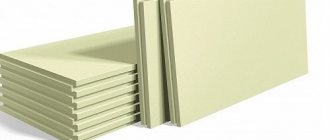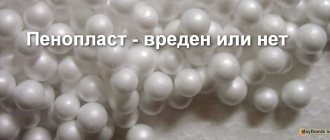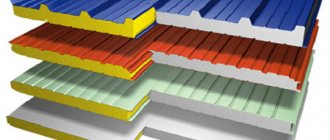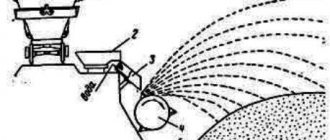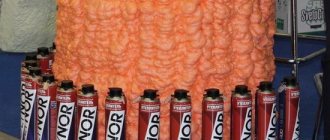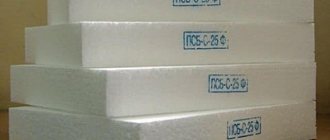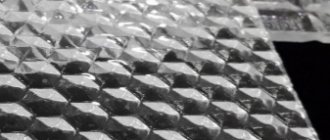Foam chips are spherical granules of polystyrene foam (expanded polystyrene) filled with isopentane gas. Foam chips are an environmentally friendly material that is easy to use and durable, thanks to which it is widely used in various industries
Expanded polystyrene chips have the following properties:
- thermal insulation;
- soundproofing;
- environmental friendliness;
- operating temperature range from -190C to +87C;
- moisture resistance;
- fire resistance;
- ease of operation and transportation;
- has no odor and does not cause allergic reactions;
- efficiency.
If all technological requirements are met, this material will last a long time and effectively. Otherwise, for example, when exposed to certain chemicals, foam chips may lose their beneficial qualities.
Features and properties of polystyrene foam granules
Expanded polystyrene granules mostly consist of air, so they retain heat well.
The raw material for granules is styrene and its copolymers. The material itself is also a heat insulator, but not so outstanding. But if you saturate the polymer melt with gas and add a blowing agent, the polystyrene particles expand in volume, fill with air and form light granules that are not connected to each other.
The particles have a regular spherical shape. Sizes range from 1 to 8 mm. Small particles are used for stuffing toys, large ones for thermal insulation. The surface of the granules is smooth and dense. They weakly adhere to each other and in volume have the property of fluidity.
Granules can be obtained in another way. Solid polystyrene foam is crushed to the original particles. In this case, some of the granules are destroyed, some are deformed. The resulting material is called crushed chips or crushed material. Its characteristics are worse: if the integrity of the sphere is damaged, the material absorbs water more strongly, contains less air, and therefore retains heat worse.
Granulated polystyrene foam, having all the qualities of slab foam, has some features. They are associated with the flowability of the material:
- Soundproofing properties - there are no rigid bonds between particles, the material cannot reflect sound, since it has an unstable structure. In addition, with loose filling, air cavities of different sizes and shapes remain between the granules, which also contributes to noise absorption.
- Spheres filled with gas are elastic. Under mechanical stress, they change shape and restore it after the load disappears.
- Bulk polystyrene foam can take any shape, change it under pressure and restore it. This property is widely used in furniture making. Granular lightweight polystyrene foam is used for stuffing pillows, chairs, armchairs, and for the manufacture of frameless furniture.
- The density of the granules coincides with the density of the tile material obtained from them. The pattern is the same: the higher the density, the heavier the material, the stronger it is and the less it absorbs moisture. However, as the density increases, the thermal insulation qualities decrease, so polystyrene that is too strong is not produced.
Another indicator of granulated polystyrene foam is bulk density, from 8 to 40 kg/cube m. The smaller the granules and the denser they are, the higher this parameter.
Popular manufacturers
Granulated polystyrene foam is offered by many manufacturers:
- Energoprommashina LLC from Yekaterinburg produces a wide variety of brands of polystyrene. Price 1 cubic meter m. from 1100 rub.
- offers expanded polystyrene packaged in 0.6 cubic meter packages. m. for 830 rub.
- LLC "Plant Plastrom" produces self-extinguishing polystyrene foam for 2000 rubles. for 1 cubic m.
- Teply Dom LLC in Orenburg produces crushed grain for 1,100 rubles. for 1 cubic m.
Purchasing the material is not difficult. Its cost is slightly higher in large cities. The price is more significantly affected by the brand, density, fraction, and treatment with fire retardants.
Characteristics and application of "Crushed"
Foam chips "Droblenka" are polymerized round crushed balls with a diameter of 2 - 7 mm, which are produced from recycled (crushed) PS waste. This manufacturing method helps to reduce the cost of this material with a partial loss of its primary shape in the foam. However, other original properties are preserved during the crushing process.
“Crushed” expanded polystyrene is used as a moisture-resistant, heat- and sound-insulating building material. The insulation made from foam chips is of high quality and inexpensive.
In addition, crushed polystyrene foam is used:
- insulating foundation slabs and walls;
- in the production of polystyrene concrete;
- in the form of shock-absorbing bedding;
- for the installation of roofing coverings with a flat slope;
- for mixtures with concrete or cement with foam chips;
- for thermal insulation of trench pipes;
- for the production of cement-sand screed;
- as the best backfill material for walls with an air gap.
The technical characteristics of crushed foam plastic should approximately correspond to the parameters of granular PS. At the same time, the distinctive indicators of the quality of “Droblenka” are the absence of large parts of uncrushed foam in the material and the low number of deformed elements.
The product is packaged in plastic bags of 0.5 and 1m3.
Prices for crushed polystyrene foam are several times lower than for granulated polystyrene and range from 150 to 250 rubles/m3.
Release forms
The initial raw material is polystyrene, which has a low density, around 1060 kg/cu m. However, the foamed version has an even lower density, so it is used mainly for insulation. They offer it in 2 forms.
In bulk form

Forms of production of expanded polystyrene - in granules and slabs
By treating the polymer with gas and a blowing agent, spherical particles with a very low density are obtained. The granules are cooled and dried, and then packed into bags. Particles are divided into fractions based on size. Different purposes require granules of different diameters.
In molded products
It is based on the same polystyrene in round granules. The finished particles are not dried, but transferred to a mold, where under the influence of temperature or temperature and pressure they are sintered, forming a single whole. The cellular structure is preserved.
This option is more convenient for external thermal insulation. You can also cut complex shapes from slabs to insulate any structures.
Foam chips - how to use?
The material is widely used in construction and repair, as well as in the industrial sector, mainly as a heat insulator or building material. Using foam chips is an extremely beneficial method of insulating foundations, walls and floors. Let's find out what the basic principles of using crushed wood are.
- Filler. The material is poured into cavities and holes in ceilings or brickwork, and is also used to level surfaces. Excellent technical properties allow foam granules to take on any shape, so the so-called cold bridges are completely eliminated. Moreover, due to its strength, the material does not deform, which cannot be said, for example, about mineral wool or expanded clay. By the way, you can find more about polystyrene foam crumbs on the website https://dnplast.dp.ua/catalog/granula_i_kroshka_penopolistirola/. But let's get back to use.

- Floor screed. Here we are talking about expanded polystyrene concrete, the preparation process of which consists of several stages. So, first, water is mixed with cement until a homogeneous mass is obtained, then, while continuing to mix, crushed powder is added (the proportions depend on the desired result). The more granules, the better the thermal insulation properties will be, but the lower the density will be. This should not be forgotten.

To obtain a floor screed solution, we recommend adhering to the following proportions:
- 4 or 5 parts crushed;
- 1 part water;
- 2 parts sand;
- 1 part cement.
Note! When working with crumbs, you should also not forget about safety precautions: you need to work away from open flames, without using chemical solutions.
Insulation with traditional materials
In some cases, it is more advisable to use traditional materials to insulate the ceiling in a house with a cold roof. They are easy to cover a horizontal plane. In addition, long-known insulation materials do not raise doubts about environmental safety. This type of thermal insulation is suitable for any floors. It can cover any ceiling:
Traditional methods do not allow you to insulate a room from the inside, but this cannot be called their disadvantage.
A layer of insulation above the ceiling protects it from external influences; in addition, thermal insulation under the ceiling affects the height of the room.
It can be concluded that internal insulation should be carried out if it is not possible to install thermal insulation from the outside.
Traditional types of thermal insulation include clay, expanded clay, straw, sawdust and glass wool. They can be used to insulate the ceiling in a wooden house. Its ceiling is a beam structure to which ceiling strips are sewn. Before laying the heat insulator, it is necessary to cover the ceiling with a waterproofing membrane. It will protect the wooden elements of the ceiling from contact with wet clay, and glass wool and other insulation materials from saturation with water vapor, after which the thermal protection will lose its performance.
Clay insulation
Straw and sawdust retain heat well, but are so fire hazardous that it is better to use them as one of the components of the solution. For example, using sawdust and clay you can make a cheap ceiling with low thermal conductivity. The disadvantage of this method is the long drying time of the solution. Straw can be used as a clay mortar filler. An additional insulation component is slaked lime. It will strengthen the thermal insulation and give it antiseptic properties.
The scheme for preparing the insulation and laying it is as follows.
- 5 volume parts of clay are soaked in 7-12 parts of water.
- 10 parts of sawdust are mixed with 1 part of lime.
- After connecting all the components and mixing the solution, fill the space between the beams.
Despite the presence of lime and sawdust, clay heat insulator can crack when drying, so it is better to apply it in layers, leveling and compacting each layer, wiping out cracks that appear as the solution dries. Sometimes copper sulfate (50 g/10 l) is added to the water prepared for the solution.
If you insulate a beam ceiling with expanded clay, then it is enough to fill the space between the beams with it. The glass wool is laid as densely as possible. If necessary, lay several layers of heat insulation, making sure that their joints at different levels do not coincide with each other. After installation, the insulation is covered with another membrane. Above it you can lay a floor made of boards, plywood or OSB.
To insulate slab and monolithic floors, you can make a screed from expanded clay concrete or a mortar from:
- 10 volumetric parts of sawdust;
- 1 part cement;
- 5-7 parts water;
- 1 part lime.
The screed is placed on a waterproofing membrane.
To install thermal insulation from glass wool, clay, expanded clay, it is better to make a wooden sheathing.
How to prepare the mixture?
Components and proportions
To get a double building material, you need to add foam chips to the concrete, which come in 2 types:
- ready-made granules;
- foam chips crushed in a crusher.
The latter option is more economically profitable, since even the remains of polystyrene foam can be crushed. So, to make concrete, you need to prepare the following components in appropriate proportions:
The use of high-grade cement and compliance with all proportions will help obtain high-quality material.
- water - 1 part;
- sand - 2 hours;
- cement - 1 part;
- foam crumbs - 4 hours.
Experienced builders strongly recommend not to skimp on working material and to use cement of a grade no lower than M500. This is explained by the fact that foam added to the concrete solution already reduces the strength of the mixture. But by using a high-quality binder, the thermal insulation material will not worsen the strength characteristics of concrete.
Advantages of polystyrene foam
One of the thinnest insulation materials
Among all insulation materials, ordinary polystyrene foam, also known as expanded polystyrene, has almost the lowest thermal conductivity coefficient. What does it mean? This means that its thickness as insulation will be the smallest compared to other materials. Here is a list of these materials in increasing order of their ability to conduct heat:
- Penoizol (50 mm).
- Foam insulation (75 mm).
- Mineral wool (125 mm).
- Wood (340 mm).
- Brick wall (900 mm).
- Concrete (2132 mm).
- the thickness of the materials at which their equality as heat insulators is achieved is indicated in brackets;
- penoizol is a liquid material that consists of several components. When they are mixed, it swells and hardens. At the same time, it acquires a porous light structure similar to hardened polyurethane foam. Its main disadvantage is toxicity. Therefore, it can only be used for insulation of non-residential premises. Usually, it is poured into a specially prepared cavity inside the wall.
The lightest insulation
Finding out the weight of polystyrene foam boards is very simple. All manufacturers indicate the density of the material on the packaging:
- 15 kg/m 3;
- 25 kg/m3;
- 35 kg/m3.
And the density of one cube is its weight. That is, one cube weighs 15, 25 and 35 kg, respectively. By the way, this is how you can check the quality of the material you buy. If the package says 25 kg/m3, and the tested package of sheets weighs less, don’t hesitate. You were a little misled.
Sometimes the manufacturer bypasses this point. For example, a package with a declared density of 25 kg/m 3 will contain sheets with a actually lower density. But this packaging will have its own beautiful name. And a pack of sheets with a real declared density will be called differently: “Warm House”, “Standard” or “What else”. But, in any case, the lighter the pack, the lower the density of the insulation. Remember this.
For work, you can use foam of any density. The main thing is to understand that the lower it is, the more fragile and fragile the sheet will be in your hands. But the use of such sheets, for example, on the first floor of a building is not recommended - the facade can easily be damaged by an impact. Therefore, the denser the sheet, the better.
One of the most inexpensive insulation materials
This is truly the most inexpensive industrial insulation material. At the same time, two types are used in construction practice:
- sheet foam;
- foam chips or balls.
Today, the selling price for both of these species is approximately equal. Most likely, this is due to an increase in demand for balls. Most often they are used for roof insulation. The cement-sand mixture is mixed with balls and poured onto the ceiling. It turns out warm, durable and inexpensive.
Polystyrene foam is a very multifunctional insulation material.
Here are its main areas of application:
- wall insulation;
- roof insulation;
- floor insulation;
- insulation of the basement of the house.
Insulating walls with foam sheets has become a classic today. The result is very warm, relatively inexpensive, quite durable and reliable. In terms of service life, polystyrene foam covered with a layer of plaster can last for a very long time. Manufacturers guarantee the service life of facades made of polystyrene foam boards without major repairs for 30 years. They say that in Germany, houses insulated with foam plastic are insured for longer periods. Up to 100 years.
What is the best way to insulate the ceiling in a house with a cold roof?
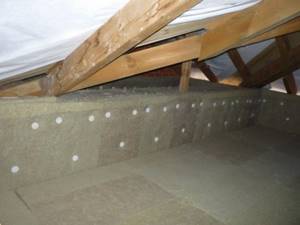
In modern construction, insulation materials are actively used to maintain the microclimate in the house as comfortable as possible for its residents. It is known that the main losses of thermal energy occur in the ceilings and roofs of buildings, so builders pay a lot of attention to their thermal insulation.
Not so long ago, the list of insulation materials was limited to a few items, and the materials listed in it were not technologically advanced. In older houses, the roofs, as a rule, are not equipped with thermal insulation, so the heating systems in buildings operate with low efficiency. Work on thermal insulation of a roof often turns out to be labor-intensive, especially since a better result is achieved after replacing the roofing material. Insulating the ceiling in a house with a cold roof is an alternative solution to the problem of maintaining heat in the premises.
Both traditional and modern materials are suitable for thermal insulation of ceilings, allowing work to be carried out both indoors and above. The main thing is that they are fire-resistant and harmless to health. When choosing insulation, you should consider where it will be installed and what additional materials will have to be purchased.
general information
In construction, concrete is defined as an artificial stone that is obtained by forming and hardening a mixture of cement with water, crushed stone and sand. It has a number of advantages: good sound insulation, strength, long service life, frost resistance, but the thermal insulation characteristics of concrete are not the best. Buildings made from it are cold and require additional insulation. Foam plastic, which is a building material containing polymers, is excellent for this purpose. It is characterized by excellent moisture resistance and thermal insulation, which allows you to protect the facade of the building from the penetration of liquids, and the interior of the room from the cold.
Production and main types
Foam chips can be obtained in two ways:
- primary. To do this, polystyrene balls are foamed using a special technology. As a result, the so-called “primary” is obtained - granules of a certain size. This technology is quite expensive and the resulting raw materials are practically not widely used in the construction industry;
- recycling. This is a secondary production method, the basis of which is pieces of foam packaging and other leftover polystyrene foam. Raw materials are placed in special devices - crushers, which crush the waste to a homogeneous fraction. The crumb diameter can be set in the machine settings. The resulting fraction is called “secondary” or “crushed”. The low cost of production has allowed this type of raw material to be widely used in many areas.
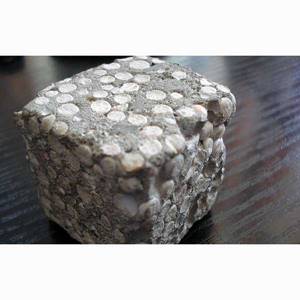
Other combination methods
Besides mixing cement mortar with concrete chips, there are other ways to combine concrete with foam. Moreover, when planning construction, it is worth paying attention to them.
Using ready-made sheets
Here you need to immediately make an important note - it is advisable to use extruded polystyrene foam. This material, although more expensive than foam, however, it significantly exceeds it in its performance characteristics:
- expanded polystyrene is denser;
- it has the best thermal and sound insulation performance;
- it is much more resistant to humidity.
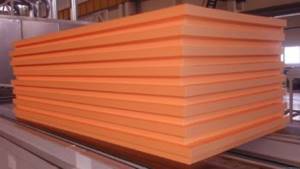
A, in addition, due to its higher density, this material has a longer service life than foam plastic.
- when floors are made, polystyrene foam sheets are used for rough flooring and laid on the base;
- concrete is poured directly onto the foam.
This approach has a number of advantages:
- the screed turns out to be thin, so its final weight is reduced;
- the floors are well insulated, in addition, they have a high level of sound insulation;
- The technology of work is very simple.
Another advantage of this method appears when installing heated floors. Due to the fact that polystyrene foam does not allow heat to pass through, their efficiency increases significantly.
In addition, you can insulate the walls with foam sheets. However, this method is best used only for exterior work with subsequent finishing. If you cover the walls with foam plastic from the inside of the room, you may encounter the problem of condensation.
Creation of permanent formwork
This is another option for combining these materials. The method is that the formwork for the construction of the building structure is constructed from polystyrene foam. And then everything is reinforced and filled with cement mortar.
- strength - concrete poured with polystyrene foam turns out monolithic, which has a positive effect on the strength of buildings;
- ease of working with the material with your own hands - polystyrene foam is easy to process;
- speed – the amount of work is reduced.
In addition, the walls are well insulated. The only negative is that subsequent finishing of the facade is required.


